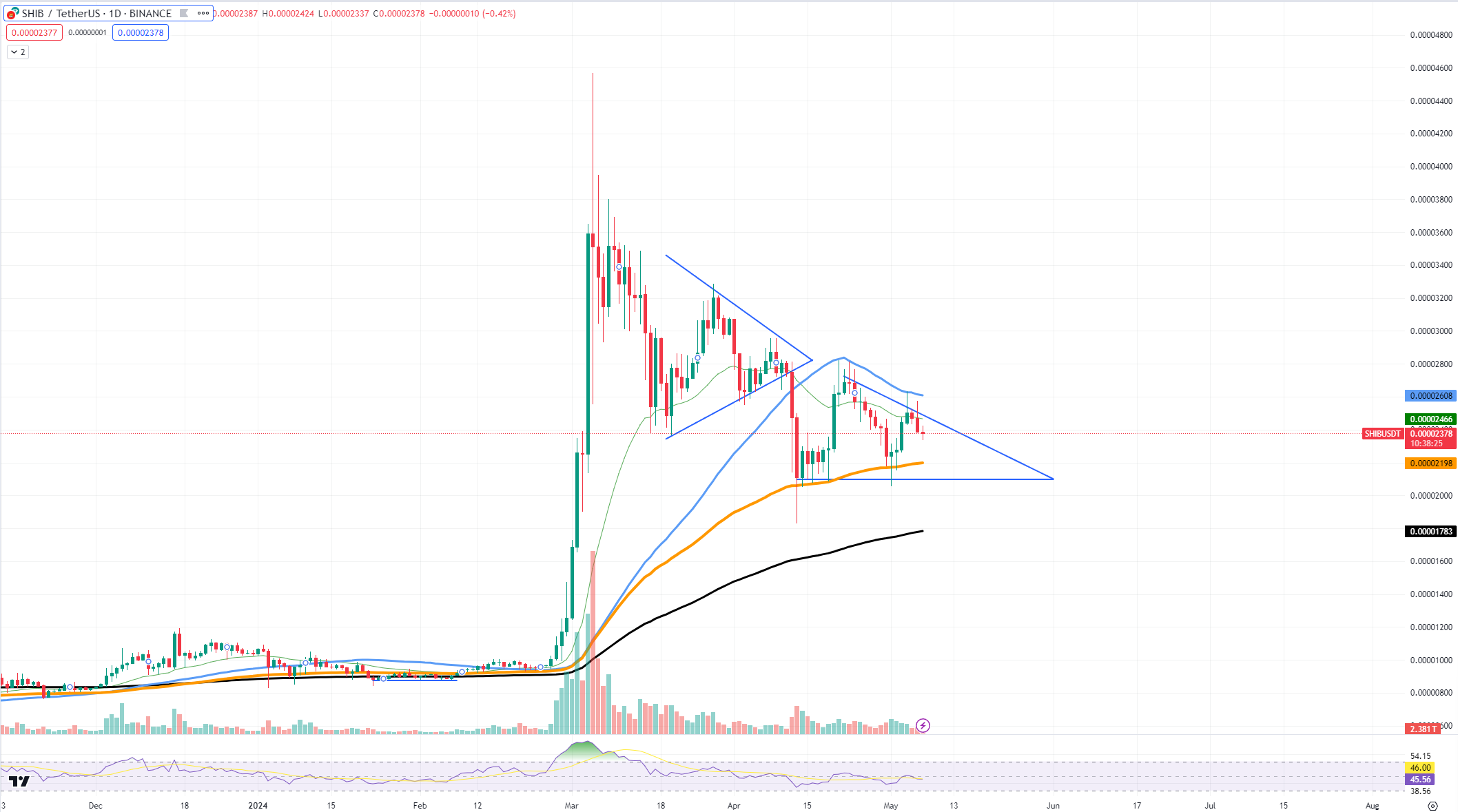Shiba Inu is currently displaying a descending triangle pattern on its trading chart, a development that could redefine its market behavior in the coming weeks. This pattern is significant as it typically signals potential continuation or a reversal, and for SHIB, the stakes are particularly high.
The descending triangle has been forming over the last few months, characterized by lower highs and a flat support line. This pattern suggests that every rally is being met with strong selling pressure, which is progressively pushing the price downward. Currently, SHIB is hovering around the $0.0000237 mark, with immediate support at $0.000021.

If this support level fails, SHIB could see a further drop toward $0.00002, a critical psychological and technical barrier. The outcome at this juncture could lead to two distinct scenarios: a rebuttal, where buyers step in strongly, pushing the price back up, potentially retesting higher resistance levels; or a breakdown, where the price could plummet below the $0.00002 mark, triggering a bearish fallout for the token.
A break below the triangle could significantly undermine confidence, leading to a potential sell-off. Conversely, a strong rebuttal and recovery from the support line could reignite interest and potentially start a new bullish cycle for SHIB.
Volume trends and market sentiment will play critical roles in determining the outcome. Recent trading volumes have been relatively low, which often indicates a lack of conviction among traders.
Bitcoin's tests
Bitcoin is testing the 26-day Exponential Moving Average (EMA), and there is notable resistance that BTC is struggling to surpass. This resistance might eventually push Bitcoin's price downwards, potentially targeting the $58,000 support level.
The $58,000 mark is significant as it has previously acted as a robust support level for Bitcoin. Observers note that the price is also near the 100-day EMA, around $60,000, which adds an additional layer of psychological and technical significance. These EMAs are critical in defining mid- to long-term market trends and sentiment, and their current levels suggest a bearish outlook for the cryptocurrency.
Volume analysis shows somewhat neutral to descending volume, which does not currently indicate strong potential for a bullish reversal. Typically, a bullish reversal is accompanied by a significant increase in volume, indicating strong buying interest that could push the price higher. The absence of such volume dynamics suggests that the market may not yet be ready to push the price back above the $60,000 mark.
Moreover, Bitcoin's failure to break through both the 26 EMA and the 50 EMA has reinforced the bearish sentiment among traders. These failures are critical as they typically indicate where the market might be heading in the short term.
Cardano's neutral position
Cardano is showing signs of a flattening trend after a period of volatility. Recently, ADA's price movement has leveled out, indicating a potential stabilization phase that could set the stage for future movements.
Currently, ADA is hovering around the mid-April support level, which it has tested multiple times without a decisive breakthrough. This support level has proven resilient, suggesting that it might serve as a strong foundation for a potential bounce upwards.
However, during its last rally to the local resistance at $0.51, ADA failed to break through, facing a downturn influenced by a bearish cross between the 50-day and 100-day Exponential Moving Averages. Such a cross is typically interpreted as a sign of accelerating negative tendencies on the market.
The price action of Cardano has been somewhat subdued following this bearish indicator, with no significant signs of a bullish reversal in the immediate term. The most likely scenario for ADA, given the current market conditions and technical setup, is the continuation of the sideways trend. This would entail the price oscillating between known support and resistance levels without significant directional momentum.
 u.today
u.today